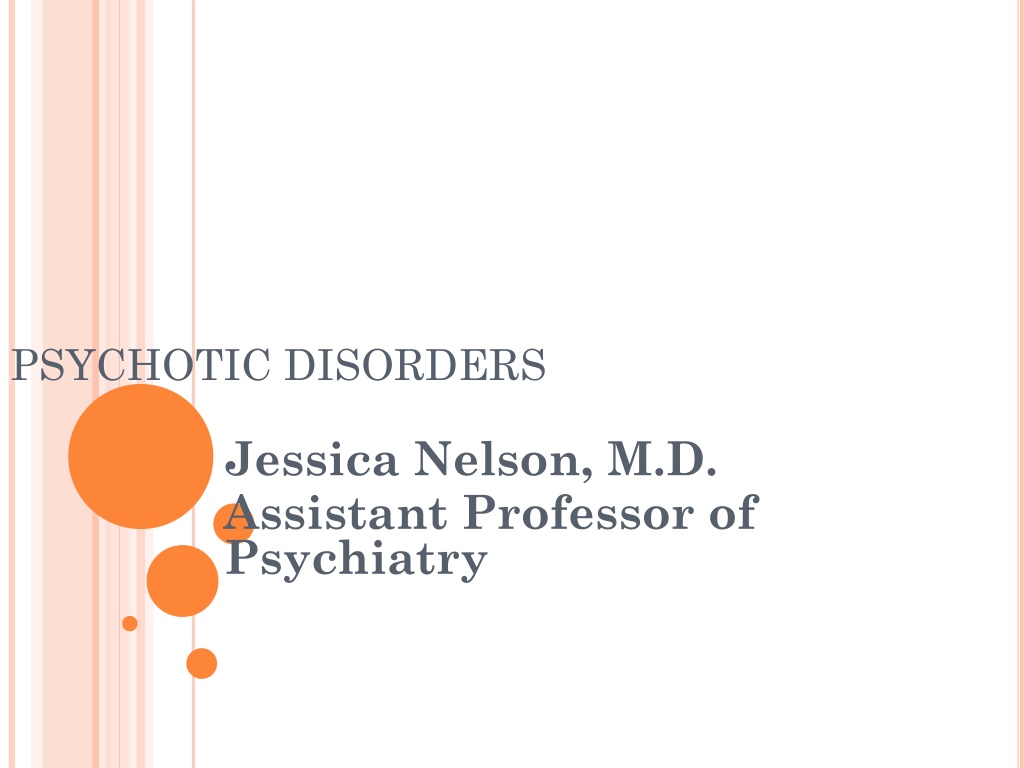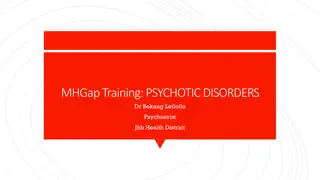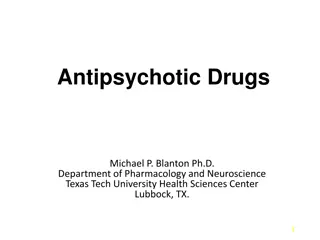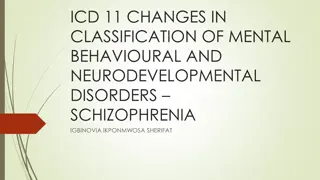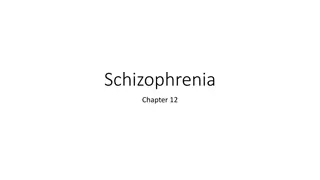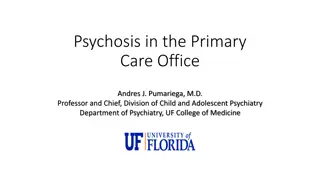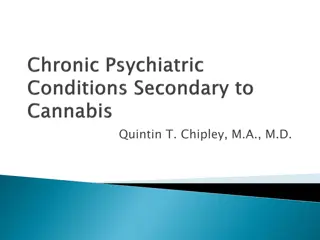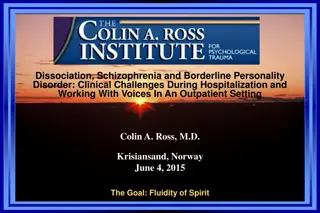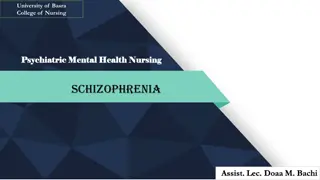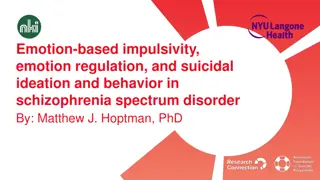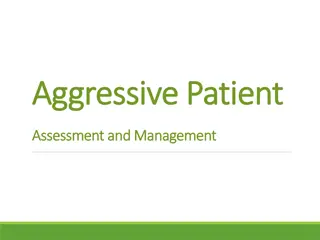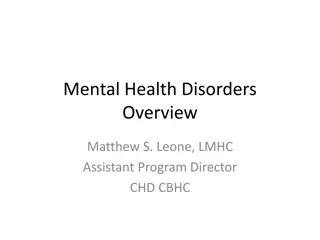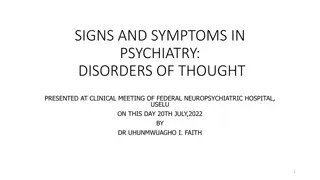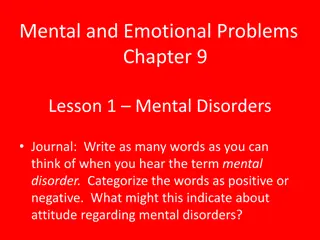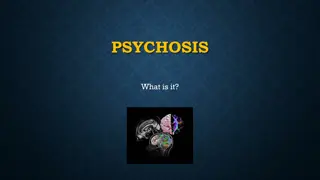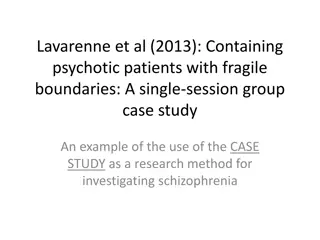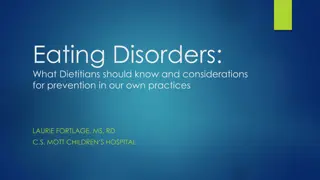Understanding Psychotic Disorders: Insights from Schizophrenia
Explore the diagnostic criteria, neurobiological factors, and differential diagnoses of psychotic disorders, focusing on Schizophrenia. Delve into the history, epidemiology, and key characteristics of Schizophrenia to gain a comprehensive understanding of this complex mental health condition.
Download Presentation

Please find below an Image/Link to download the presentation.
The content on the website is provided AS IS for your information and personal use only. It may not be sold, licensed, or shared on other websites without obtaining consent from the author. Download presentation by click this link. If you encounter any issues during the download, it is possible that the publisher has removed the file from their server.
E N D
Presentation Transcript
PSYCHOTIC DISORDERS Jessica Nelson, M.D. Assistant Professor of Psychiatry
OBJECTIVES 1. Know and understand the diagnostic criteria for schizophrenia, the major psychotic disorder 2. Know the neurotransmitters suspected in the pathophysiology of schizophrenia 3. Understand the good and poor prognostic factors in psychotic disorders 2
OBJECTIVES 4. Understand that psychotic symptoms can be due to disorders other than schizophrenia 5. Be able to make a reasonable differential diagnosis of a patient with psychotic symptoms 3
TYPESOF PSYCHOTIC DISORDERS Schizophrenia (DSM IV-TR, V) Schizophreniform Disorder (DSM IV-TR, V) Schizoaffective Disorder (DSM IV-TR, V) Delusional Disorder (DSM IV-TR, V) Brief Psychotic Disorder (DSM IV-TR, V) Other Psychotic Disorder (DSM V) Secondary Psychotic Disorders (DSM IV-TR, V) Catatonia (DSM V) 4
SCHIZOPHRENIA-HISTORY Emil Kraepelin (1856-1926)- described patients with dementia praecox as distinct from those with manic-depressive psychosis Eugen Bleuler (1857-1939)- coined the word schizophrenia; described the classic 4 A s of schizophrenia: associations, affect, autism, ambivalence 5
SCHIZOPHRENIA-EPIDEMIOLOGY Prevalence: General Population 1% Non twin sibling of a schizophrenia patient 8% Child with one parent with schizophrenia 12% Dizygotic twin of a schizophrenia patient 12% Child of two parents with schizophrenia 40% Monozygotic twin of a schizophrenia patient 50% 6
SCHIZOPHRENIA-EPIDEMIOLOGY Age: Peak onset 18-25 males, 25-35 females Women have a bimodal distribution, with a second peak appearing in middle age Onset after age 45 is considered late onset (very rare after age 60); generally paranoid, better prognosis Childhood onset is rare, but does occur 90% of patients in treatment are ages15-55 7
SCHIZOPHRENIA-EPIDEMIOLOGY Gender: equal in men and women, but outcomes are better for women Birth Season: higher rates in winter and early spring births Obstetrical and perinatal complications increase the risk for schizophrenia Higher rates in influenza epidemics and maternal starvation Geography: higher in urban areas of industrialized countries, higher in some regions, i.e. Ireland 8
SCHIZOPHRENIA-EPIDEMIOLOGY Non-psychiatric morbidity and mortality: Higher death rate from accidents Higher rates of sudden death Higher rates of metabolic syndrome: insulin resistance, hypertension, dyslipidemia, increased waist circumference Up to 80% of patients with schizophrenia have concurrent medical illnesses, half of which are undiagnosed 9
SCHIZOPHRENIA-EPIDEMIOLOGY Suicide: 10-15% of patients with schizophrenia commit suicide 50% attempt suicide Risk factors: male, young, post-psychotic depression, realistic assessment of deterioration due to illness 10
SCHIZOPHRENIA-EPIDEMIOLOGY Substance Use: Cigarette Smoking 75-90% of patients smoke (there may be brain abnormalities in nicotinic receptors in schizophrenia) Increases the metabolism of some antipsychotics Nicotine appears to improve some cognitive impairments (may decrease positive symptoms) 11
SCHIZOPHRENIA-EPIDEMIOLOGY Substance Use: Alcohol 30-50% meet criteria for abuse or dependence Cannabis and cocaine are the two other commonly used drugs. High cannabis use increases risk of developing schizophrenia by 6x Alcohol and drug use are associated with a poor prognosis 12
SCHIZOPHRENIA-EPIDEMIOLOGY Socioeconomic and Cultural Factors: In industrialized nations a disproportionate number of patients are in the low SE groups: downward drift hypothesis vs. social causation hypothesis Recent immigrants have a higher rate, suggesting the stress of abrupt cultural change as a risk Population density-prevalence rises with increasing density in cities of > 1 million 13
SCHIZOPHRENIA-EPIDEMIOLOGY Economics: Onset at a young age, requires life-long care Accounts for 2.5% of all health care expenditures 75% of patients are unemployed Direct and indirect costs >$50 billion annually Half of psychiatric beds occupied by these patients 40-60% are re-admitted within 2 years of their first hospitalization 1/3-2/3 of the homeless have schizophrenia 14
SCHIZOPHRENIA-ETIOLOGY Schizophrenia is not a single disease, but a group of disorders with heterogeneous causes Stress-Diathesis Model: The person has a specific vulnerability (diathesis) that when acted on by a stress leads to the development of schizophrenia. The stress can be environmental or biological or both. 15
SCHIZOPHRENIA-ETIOLOGY Genetic Factors: Significant genetic contribution to some, perhaps all, forms of schizophrenia, involving multiple genes Paternal age: direct correlation of increased risk with advancing paternal age (perhaps spermatogenesis in older men is subject to greater epigenetic damage) 16
SCHIZOPHRENIA-ETIOLOGY-NEUROBIOLOGY Schizophrenia is a complex neurodevelopmental disorder without one cause, defect or manifestation. Research implicates dysfunction in certain areas of the brain, primarily in the limbic system and basal ganglia, including the cerebral cortex, thalamus and brainstem. Some patients have loss of brain volume believed to be due to reduced density of axons, dendrites, and synapses. 17
WENOWHAVEEVIDENCETHAT MULTIPLENEUROTRANSMITTERSARE INVOLVEDINTHEPATHOPHYSIOLOGY OFSCHIZOPHRENIA, BUTFORYEARS HYPOTHESESFOCUSEDONASINGLE ONE, ANDTHATISWHATEARLY ANTIPSYCHOTICSTARGETED. NEWER DRUGSALSOAFFECTTHIS NEUROTRANSMITTER, ASWELLAS OTHERS. WHICHONEHASITSOWN HYPOTHESIS? 37% 30% 20% 13% Serotonin GABA Dopamine Acetylcholine A. B. C. 18 D. A. B. C. D.
SCHIZOPHRENIA-ETIOLOGY- NEUROTRANSMITTERS The Dopamine Hypothesis of Schizophrenia: Disease results from too much dopaminergic activity as evidenced by: Dopamine receptor antagonists are effective antipsychotics Drugs that increase dopamine (amphetamines) are psychotomimetics This basic theory doesn t speculate on whether the dopaminergic hyperactivity is due to excessive release of dopamine, excessive number of dopamine receptors, hypersensitivity of receptors, or some combination. 19
SCHIZOPHRENIA-ETIOLOGY-NEUROTRANSMITTERS It has become clear in recent years that the dopamine hypothesis is not sufficient: Newer theories posit serotonin excess The serotonin antagonist activity of clozapine and other atypical antipsychotics support this, as does the psychotomimetic effect of the serotonin agonist LSD A single neuron can contain more than one neurotransmitter and can have receptors for 6 or more neurotransmitters 20
SCHIZOPHRENIA-ETIOLOGY-NEUROTRANSMITTERS Norepinephrine likely modulates the dopaminergic system, and the prominent feature of anhedonia suggests dysfunction in the norepinephrine reward neural system GABA has a regulatory effect on dopamine activity, and the loss of GABAergic neurons seen in the hippocampus of some patients could lead to hyperactivity of dopaminergic neurons 21
SCHIZOPHRENIA-ETIOLOGY-NEUROTRANSMITTERS Glutamate is implicated because phencyclidine (PCP), a glutamate antagonist, causes psychosis. New drugs are in development that influence glutamate Acetylcholine and nicotine are suspected, as postmortem studies show decreased muscarinic and nicotinic receptors (important in cognition) Substance P and neurotensin are two neuropeptides with altered concentrations in psychosis 22
SCHIZOPHRENIA-ETIOLOGY-NEUROPATHOLOGY Limbic system Post-mortem studies show decreased size in this region, including the amygdala, hippocampus, and parahippocampal gyrus Disorganization of neurons within the hippocampus has also been reported The limbic system is important in controlling emotions 23
SCHIZOPHRENIA-ETIOLOGY-NEUROPATHOLOGY Basal Ganglia and Cerebellum are of theoretical interest for several reasons: Many antipsychotic drug-naive schizophrenia patients show odd movements: awkward gait, facial grimacing, and stereotypies Movement disorders involving the basal ganglia are more commonly associated with psychosis than are other neurological disorders 24
SCHIZOPHRENIA-ETIOLOGY-NEUROPATHOLOGY Cerebral ventricles: lateral and third ventricle enlargement and some degree of reduction in cortical volume. Reduced Symmetry: present in several brain areas, including temporal, frontal, and occipital lobes Believed by some to originate during fetal life and to be indicative of a disruption in brain lateralization during neurodevelopment 25
SCHIZOPHRENIA-ETIOLOGY- NEUROPATHOLOGY Prefrontal Cortex: postmortem studies show anatomical abnormalities in this region, and imaging has shown functional deficits Some symptoms of illness are shared with patients with frontal lobe syndromes and those who underwent prefrontal lobotomies years ago Thalamus: some patients (including antipsychotic-naive) have shown volume shrinkage or neuronal loss in particular thalamic subnuclei 26
SCHIZOPHRENIA-ETIOLOGY- NEUROPATHOLOGY Electroencephalography (EEG): Many schizophrenic patients have abnormal EEG s They also have an inability to filter out irrelevant sounds and are extremely sensitive to background noise Complex partial epilepsy: schizophrenia-like psychoses occur more commonly than expected, particularly with a left-sided seizure focus, medial temporal location of lesion, and early onset of seizures 27
SCHIZOPHRENIA-ETIOLOGY- NEUROPATHOLOGY Evoked Potentials: a number of abnormalities have been found, both positive and negative. Most studied is the P300; a large positive EP wave that occurs about 300msec after a sensory stimulus. The major source of the P300 may be in limbic system structures of the medial temporal lobes 28
SCHIZOPHRENIA-ETIOLOGY- NEUROPATHOLOGY Eye Movement Dysfunction: 50-85% of pts, 25% of other psych pts, and 10% of controls Inability to accurately follow a moving visual target; independent of drug treatment and also found in first degree relatives of patients Eye movement is partly controlled by centers in the frontal lobes; a disorder in eye movement is consistent with theories that implicate a frontal lobe pathological process in schizophrenia 29
SCHIZOPHRENIA-ETIOLOGY- NEUROPATHOLOGY Psychoneuroimmunology: Decreased T cell interleukin-2 production Reduced number and responsiveness of peripheral lymphocytes Abnormal cellular and humoral reactivity to neurons Presence of brain-directed antibodies Relevance of these abnormalities is unclear 30
SCHIZOPHRENIA-ETIOLOGY- NEUROPATHOLOGY Psychoneuroendocrinology: Many studies have shown differences in hormone levels and responses to stimulation and suppression tests between groups of patients with schizophrenia and groups of control subjects 31
SCHIZOPHRENIA-ETIOLOGY-SOCIAL Psychosocial Factors: Many theories over the years blamed the family, especially the mother, for the development of schizophrenia; these have been largely discredited. It has been shown that patients living with parents or other caretakers with high levels of expressed emotion (criticism, hostility, over involvement) have high relapse rates 32
SCHIZOPHRENIA-DIAGNOSIS DSM IV-TR and DSM V (Diagnostic and Statistical Manual of Mental Disorders) Diagnostic Criteria for Schizophrenia (criteria A-F must all be met): 33
SCHIZOPHRENIA DIAGNOSIS A. Characteristic symptoms: Two (or more) of the following, each present for a significant portion of time during a 1 month period (or less if successfully treated): 1) Delusions 2) Hallucinations 3) Disorganized speech (i.e. frequent derailment or incoherence) 4) Grossly disorganized or catatonic behavior 5) Negative symptoms (i.e. affective flattening, alogia, or avolition) 34
SCHIZOPHRENIA-DIAGNOSIS Note: Only one Criterion A symptom is required if delusions are bizarre or hallucinations consist of a voice keeping up a running commentary on the person s behavior or thoughts, or two or more voices conversing with each other. 35
SCHIZOPHRENIA-DIAGNOSIS B. Social/occupational dysfunction: For a significant portion of the time since the onset of the disturbance, one or more major areas of functioning such as work, interpersonal relations, or self-care are markedly below the level achieved prior to the onset (or when the onset is in childhood or adolescence, failure to achieve expected level of interpersonal, academic, or occupational achievement) 36
SCHIZOPHRENIA-DIAGNOSIS C. Duration: Continuous signs of the disturbance persist for at least 6 months. This 6 month period must include at least 1 month of symptoms (or less if successfully treated) that meet Criterion A (i.e. active phase symptoms) and may include periods of prodromal or residual symptoms. During these prodromal or residual periods, the signs of the disturbance may be manifested by only negative symptoms or two or more symptoms listed in Criterion A presented in an attenuated form (e.g. odd beliefs, unusual perceptual experiences). 37
SCHIZOPHRENIA-DIAGNOSIS D. Schizoaffective and mood disorder exclusion: Schizoaffective disorder and mood disorder with psychotic features have been ruled out because either (1) no major depressive, manic or mixed episodes have occurred concurrently with the active-phase symptoms; or (2) if mood episodes have occurred during active-phase symptoms, their total duration has been brief relative to the duration of the active and residual periods. 38
SCHIZOPHRENIA-DIAGNOSIS E. Substance/general medical condition exclusion: The disturbance is not due to the direct physiological effects of a substance (e.g. a drug of abuse, a medication) or a general medical condition 39
SCHIZOPHRENIA-DIAGNOSIS F. Relationship to a pervasive developmental disorder: If there is a history of autistic disorder or another pervasive developmental disorder, the additional diagnosis of schizophrenia is made only if prominent delusions or hallucinations are also present for at least a month (or less if successfully treated). 40
A 25-YEAR-OLDMARRIEDMANWHOISEMPLOYEDAT AHARDWARESTOREDEVELOPSPSYCHOTIC SYMPTOMSDURINGATWO-WEEKPERIODAFTERHIS FATHER SSUDDENDEATH. HEFEELSSADNESSAND HEARSHISFATHER SVOICETELLINGHIMTOJOIN HIM. HEHASNOPRIORPSYCHIATRICHISTORY, BUT FAMILYHISTORYISNOTABLEFORABROTHERWITH SCHIZOPHRENIA. WHICHOFTHEFOLLOWINGIS THEPOORESTPROGNOSTICSIGNFORTHISPATIENT? Depression Family History Marital Status Acute Onset A. B. C. D. 0% 0% 0% 0% 41 A. B. C. D.
SCHIZOPHRENIA-GOOD PROGNOSIS Late Onset Obvious precipitating factors Acute onset Good premorbid social, sexual, and work histories Mood disorder symptoms (especially depressive symptoms) Married Family history of mood disorders Good support systems Positive symptoms 42
SCHIZOPHRENIA-POOR PROGNOSIS Young onset No precipitating factors Insidious onset Poor premorbid social, sexual, and work histories Withdrawn, autistic behavior Single, divorced, or widowed Poor support systems 43
SCHIZOPHRENIA-POOR PROGNOSIS Negative Symptoms Neurological signs and symptoms History of perinatal trauma No remission in 3 years Many relapses History of assaultiveness Family history of schizophrenia 44
SCHIZOPHRENIA-PSYCHOLOGICALTESTING Schizophrenia is a brain disease that disrupts the normal functioning of many cognitive abilities Vigilance, memory, and concept formation are most affected and consistent with frontotemporal cortical defects Frequently there are impairments in attention, retention time, and problem solving ability Motor ability is also impaired IQ is lower at onset of illness and may deteriorate with progression of the disorder Projective tests may indicate bizarre ideation 45
SCHIZOPHRENIA-MENTAL STATUS EXAM Appearance: Hygiene may be poor Dress may be odd Motor Behavior: Eye contact may be poor, or patient may stare or look around the room if paranoid Psychomotor agitation or retardation may be present Evaluate for posturing, grimacing, echopraxia, echolalia Look for medication side effects, EPS or TD 46
SCHIZOPHRENIA-MENTAL STATUS EXAM Mood: Patient report of recent mood Affect: what the examiner sees: sad, tearful, blunted, flat, agitated, reactive, appropriate, inappropriate, congruent (or not) with mood Speech: spontaneous or not, rate, tone, volume, rhythm 47
SCHIZOPHRENIA-MENTAL STATUS EXAM Perceptual Disturbances-Hallucinations: Auditory-most common, frequently derogatory Visual-also consider substance use or medication side effect. Can be seen in some forms of dementia. Tactile-uncommon; consider cocaine or delirium. Gustatory and olfactory-uncommon in schizophrenia- consider neurologic disorder. 48
SCHIZOPHRENIA-MENTAL STATUS EXAM Thought Content-Delusions (fixed, false beliefs): Paranoid: being watched, followed, listened to, spied on, poisoned, plotted against Somatic: believing one is infested with parasites, insides are being eaten, or has HIV even in face of repeated negative tests 49
SCHIZOPHRENIA-MENTAL STATUS EXAM Delusions: Of Control: a person or force is controlling one s mind or body Thought Broadcasting: one s thoughts are being broadcast out loud Thought Withdrawal: others are taking thoughts out of one s mind Thought Insertion: others are putting thoughts in one s mind Ideas of Reference: events have to do with you-newscaster gave a message aimed at you on the news 50
